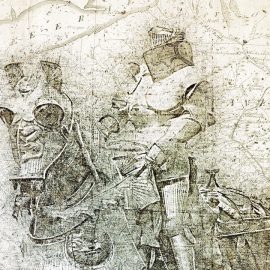

This article is an excerpt from the Shortform book guide to "Skin in the Game" by Nassim Nicholas Taleb. Shortform has the world's best summaries and analyses of books you should be reading.
Like this article? Sign up for a free trial here .
Are humans more peaceful or destructive by nature? Is peace in society possible without central overseeing authority?
In his book Skin in the Game, Nassim Taleb argues that peace is a natural state of human civilization. However, many people falsely assume that the natural state of civilization is ceaseless, destructive conflict, which leads them to believe that institutions need to intervene.
In this article, we’ll explain why Taleb sees peace as the dominant status of civilization and how, when left to their own devices, people tend to resolve conflict and collaborate.
Humans Progress Toward Peace
Typically, over time, people find ways to coexist peacefully. According to Nassim Taleb, even war is just a stepping-stone toward longer eras of peace and collaboration.
War puts mass skin in the game, not only for the people doing the fighting but everyone who bears the risks of war—all civilians who suffer domestic turmoil and a stressed economy. The mutual drain of resources required by war puts constant pressure for peace on both sides.
According to Taleb, conflict is much more the exception than the rule. In most cases, both sides decide relatively quickly what trades or concessions they are willing to make, and peace is restored. In this way, people with skin in the game tend toward peace and collaboration.
| Taleb and Pinker on Peace in Society Taleb has engaged in a lengthy feud with psychologist Steven Pinker on the topic of whether or not violence has declined over the course of history. Taleb’s chapter on war is partially a response to Pinker’s 2011 book The Better Angels of Our Nature, in which he argues that the world is safer and more peaceful than ever before. Pinker credits this in part to powerful democratic human institutions such as the United Nations that Taleb disdains. Taleb argues that the seventy or so years of overwhelming peace we’ve had since World War II could simply be a statistically predictable gap between massive wars, and that centralized institutions intended to create peace often cause more conflict than they resolve, as we’ll see next. |
Institutions Propel War
There is an exception, however. All the longest and most intense conflicts are driven by institutions without skin in the game of the war. If the ones ordering the war aren’t personally suffering its dire consequences, it’s more likely to continue.
For Taleb, this is another reason why decentralized states are better than a large unified nation—centralized governments are more likely to participate in deadlier wars because the decision-makers are farther away from the people making the sacrifices.
This idea can be illustrated by the widespread disillusionment of Americans regarding the Vietnam War. In 1970, two-thirds of Americans believed the war was a mistake, yet it continued until 1975. Since the central decision-makers had power over the entire US population, many people were drafted and suffered as a result of someone else’s beliefs—a skin in the game asymmetry which prolonged the conflict.
Problems With Externally-Imposed Peace
In Taleb’s view, once conflict has begun, only those engaged in the conflict have the ability to stop it. Foreign efforts to implement peace by powers without skin in the game cause more problems than they solve.
They often entirely misunderstand the wars’ root causes, due to their lack of direct experience with the conflict.
Even if a war is settled on paper among dignitaries, if the people themselves aren’t the ones to reconcile, the underlying conflict won’t go away.
| Institutional Failures in the Israeli-Palestinian Conflict In the book, Taleb argues this point with the example of the Israeli-Palestine Conflict, which has been raging for more than seventy years—due to foreign intervention, in Taleb’s eyes. Let’s take a quick simplified look at key moments in the history of this conflict through the lens of skin in the game. Arguably, the first significant foreign intervention spurring this conflict was the 1917 Balfour Declaration, when Britain gave an undefined part of Palestine to Zionists lobbying for the creation of a Jewish homeland there. The Jewish population in Palestine grew, and hostility between them and the Arabs already there intensified to the point of armed conflict. In 1947, in the aftermath of the Holocaust, the United Nations gave Jews their own state, Israel, prompting Palestinians to go to war to reclaim the land, supported by foreign intervention from the Arab League. They lost the war, prompting Israel to take even more Palestinian land. At each of these events, foreign bodies without skin in the game intervened at a distance from the consequences. Taleb argues that if, at either one of these junctures, world powers would have simply let Israel and Palestine solve their own problems, the conflict would have been resolved by now. In 1993, a pair of peace treaties called the Oslo Accords were signed between the Israeli and Palestinian governments, but this didn’t last long, because, Taleb argues, “no peace proceeds from bureaucratic ink”—the people actually living in Israel and Palestine were dissatisfied with this agreement. In Taleb’s eyes, both states’ governments lacked skin in the game, as neither side achieved the desires of the people they were representing. |

———End of Preview———
Like what you just read? Read the rest of the world's best book summary and analysis of Nassim Nicholas Taleb's "Skin in the Game" at Shortform .
Here's what you'll find in our full Skin in the Game summary :
- Why having a vested interest is the single most important contributor to human progress
- How some institutions and industries were completely ruined by not being invested
- Why it's unethical for you to not have skin in the game






